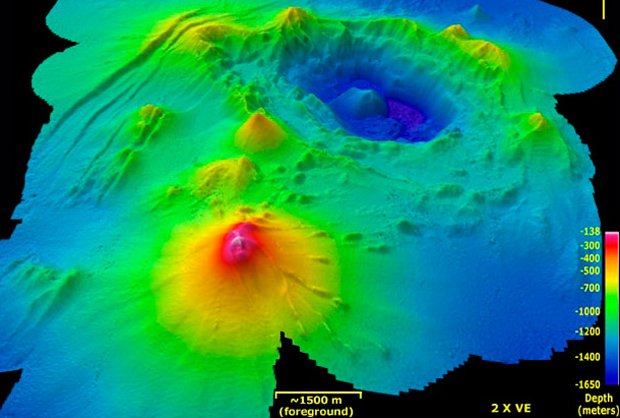Submarine volcano grows at record rate

THE MONOWAI CONE volcano, 1000km north of New Zealand, underwent an unprecedented period of growth and collapse in mid-2011, providing new insight into the behaviour of submarine volcanoes.
Over a period of just five days, the volcano spewed out about 8.5 million cubic metres of lava and debris. One portion of the summit grew by a whopping 79m – equivalent to a 26-storey building – while another collapsed by 19m.
The changes were measured by scientists aboard the German research vessel Sonne, with the study of the Monowai Cone aided by Dr Cornel de Ronde from GNS Science in New Zealand.
The findings of the three-week survey were published last week in the journal Nature Geoscience.
The Monowai Cone

The Kermadec Arc, between New Zealand and Tonga. (Credit: GNS Science)
“There are very few documented examples of volcanoes growing this fast, and they are all from on-land examples – this is the fastest known growing volcano on the bottom of the sea,” Cornel told Australian Geographic.
The crew on the Sonne took bathymetric (underwater topographic) measurements of the volcano at two separate times during the survey, about three weeks apart, which is something rare in the study of submarine volcanoes, Cornel says. “Deep sea research is an expensive business, rarely can we go back and re-survey a volcano within a few weeks or during the same expedition.”
The Monowai Cone lies at the intersection of the Pacific and Indo-Australian tectonic plates at the Tonga-Kermadec Arc – a 2500km-long chain of volcanoes stretching from New Zealand to Tonga.
According to Dr Richard Arculus from The Australian National University, it is among the most active arc volcanoes in the world.
The importance of submarine volcanoes
“Submarine volcanism in island arcs…is a frontier area of study,” Richard says. He commended the researchers for making “accurate, repeat measurements of volcano morphology over a limited period of time as opposed to sporadic and widely spaced mapping efforts.”
Studying submarine volcanoes gives us insight into how the seafloor becomes shaped by natural processes, but it can also offers clues for mining mineral deposits on land.
Cornel says that these kind of studies provide exploration companies “with a better understanding of where to look for these mineral deposits in uplifted terrains of ancient seafloor.”
In rare cases these submarine volcanoes could prove hazardous to shipping, Cornel says: “Where the volcanoes are shallow – say less than 400m in depth – they can erupt and expel enormous amounts of gas into the water column, effectively preventing any vessel from floating if they were situated immediately above the volcano.”
RELATED STORIES

